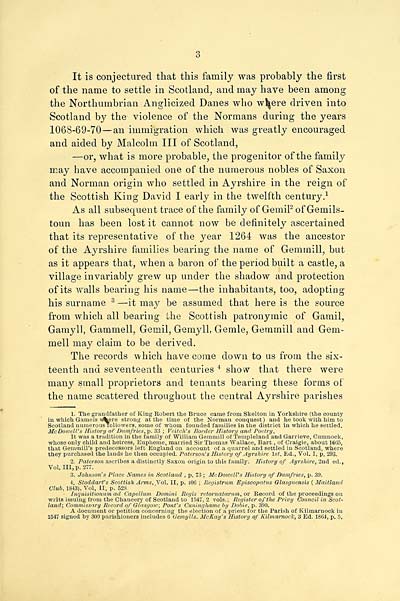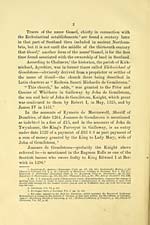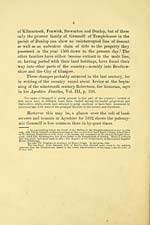Download files
Complete book:
Individual page:
Thumbnail gallery: Grid view | List view

It is conjectured that this family was probably the first
of the name to settle in Scotland, and may have been among
the Northumbrian Anglicized Danes who w^ere driven into
Scotland by the violence of the Normans during the years
1068-69-70 — an immigration which was greatly encouraged
and aided by Malcolm III of Scotland,
— or, what is more probable, the progenitor of the family
may have accompanied one of the numerous nobles of Saxon
and Norman origin who settled in Ayrshire in the reign of
the Scottish King David I early in the twelfth century. 1
As all subsequent trace of the family of Gemil 2 of Gemils-
toun has been lost it cannot now be definitely ascertained
that its representative of the year 1264 was the ancestor
of the Ayrshire families bearing the name of Geminill, but
as it appears that, when a baron of the period built a castle, a
village invariably grew up under the shadow and protection
of its walls bearing his name — the inhabitants, too, adopting
his surname 3 — it may be assumed that here is the source
from which all bearing the Scottish patronymic of Gamil,
Gamyll, Gammell, Gemil, Gemyll, Gemle, Gemmill and Gem-
mell may claim to be derived.
The records which have come down to us from the six-
teenth and seventeenth centuries 4 show that there were
many small proprietors and tenants bearing these forms of
the name scattered throughout the central Ayrshire parishes
1. The grandfather of King Robert the Bruce came from Skelton in Yorkshire (the county
in which Gameis wfcere strong at the time of the Norman conquest) and he took with him to
Scotland numerous followers, some of whom founded families in the district in which he settled.
McDowell's History of Dumfries, p. 33 ; Veitch's Border History and Poetry,
It was a tradition in the family of William Gemmill of Templeland and G-arrieve, Cumnock,
whose only child and heiress, Eupheme, married Sir Thomas Wallace, Bart., of Craigie, about 1605,
that GemmiU's predecessors left England on account of a quarrel and settled in Scotland, where
they purchased the lands he then occupied. Patersou's History of Ayrshire 1st. Ed., Vol. I, p. 293.
2. Paterson ascribes a distinctly Saxon origin to this family. History of Ayrshire, 2nd ed.,
Vol. Ill, p. 277.
3. Johnson's Place Names In Scotland , p. 73 ; McDowell's History of Dumfries, p. 39.
4. Stoddart's Scottish Arms, Vol. II, p. 406 ; Registrum Episcopatus Glasguensis ( Maltland
Club, 1S43), Vol. II, p. 528.
Inquisltlonum ad Capellum Domini Regis retornatarum, or Record of the proceedings on
writs issuing from the Chancery of Scotland to 1547,2 vols.; Register of the Privy Council in Scot-
land] Commissary Record of Glasgow, Pout's Cunlnghame by Doble, p. 390.
A document or petition concerning the election of a priest for the Parish of Kilmarnock in
1547 signed by 300 parishioners includes 6 Gemylls. McKay's History of Kllmai~nock, 3 Ed. 1864, p. 5.
of the name to settle in Scotland, and may have been among
the Northumbrian Anglicized Danes who w^ere driven into
Scotland by the violence of the Normans during the years
1068-69-70 — an immigration which was greatly encouraged
and aided by Malcolm III of Scotland,
— or, what is more probable, the progenitor of the family
may have accompanied one of the numerous nobles of Saxon
and Norman origin who settled in Ayrshire in the reign of
the Scottish King David I early in the twelfth century. 1
As all subsequent trace of the family of Gemil 2 of Gemils-
toun has been lost it cannot now be definitely ascertained
that its representative of the year 1264 was the ancestor
of the Ayrshire families bearing the name of Geminill, but
as it appears that, when a baron of the period built a castle, a
village invariably grew up under the shadow and protection
of its walls bearing his name — the inhabitants, too, adopting
his surname 3 — it may be assumed that here is the source
from which all bearing the Scottish patronymic of Gamil,
Gamyll, Gammell, Gemil, Gemyll, Gemle, Gemmill and Gem-
mell may claim to be derived.
The records which have come down to us from the six-
teenth and seventeenth centuries 4 show that there were
many small proprietors and tenants bearing these forms of
the name scattered throughout the central Ayrshire parishes
1. The grandfather of King Robert the Bruce came from Skelton in Yorkshire (the county
in which Gameis wfcere strong at the time of the Norman conquest) and he took with him to
Scotland numerous followers, some of whom founded families in the district in which he settled.
McDowell's History of Dumfries, p. 33 ; Veitch's Border History and Poetry,
It was a tradition in the family of William Gemmill of Templeland and G-arrieve, Cumnock,
whose only child and heiress, Eupheme, married Sir Thomas Wallace, Bart., of Craigie, about 1605,
that GemmiU's predecessors left England on account of a quarrel and settled in Scotland, where
they purchased the lands he then occupied. Patersou's History of Ayrshire 1st. Ed., Vol. I, p. 293.
2. Paterson ascribes a distinctly Saxon origin to this family. History of Ayrshire, 2nd ed.,
Vol. Ill, p. 277.
3. Johnson's Place Names In Scotland , p. 73 ; McDowell's History of Dumfries, p. 39.
4. Stoddart's Scottish Arms, Vol. II, p. 406 ; Registrum Episcopatus Glasguensis ( Maltland
Club, 1S43), Vol. II, p. 528.
Inquisltlonum ad Capellum Domini Regis retornatarum, or Record of the proceedings on
writs issuing from the Chancery of Scotland to 1547,2 vols.; Register of the Privy Council in Scot-
land] Commissary Record of Glasgow, Pout's Cunlnghame by Doble, p. 390.
A document or petition concerning the election of a priest for the Parish of Kilmarnock in
1547 signed by 300 parishioners includes 6 Gemylls. McKay's History of Kllmai~nock, 3 Ed. 1864, p. 5.
Set display mode to:
![]() Universal Viewer |
Universal Viewer | ![]() Mirador |
Large image | Transcription
Mirador |
Large image | Transcription
Images and transcriptions on this page, including medium image downloads, may be used under the Creative Commons Attribution 4.0 International Licence unless otherwise stated. ![]()
| Histories of Scottish families > Note on the probable origin of the Scottish surname of Gemmill or Gemmell > (11) Page 3 |
|---|
| Permanent URL | https://digital.nls.uk/95619831 |
|---|
| Description | A selection of almost 400 printed items relating to the history of Scottish families, mostly dating from the 19th and early 20th centuries. Includes memoirs, genealogies and clan histories, with a few produced by emigrant families. The earliest family history goes back to AD 916. |
|---|

